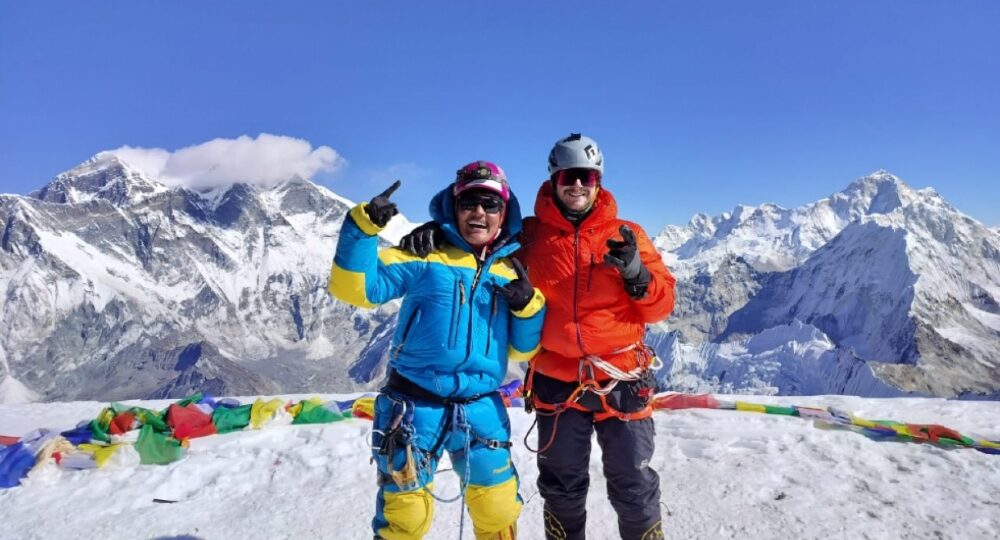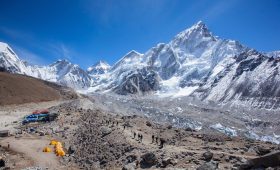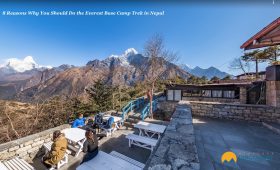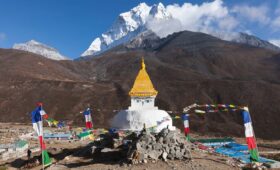‘Peak Climbing’ is one of the most popular adventures in Nepal. Being a country of snow-capped mountains, Nepal emerges as the leading scoreboard regarding the tourism industry. Peaks like Mount Everest, Kanchenjunga, Annapurna, and Manaslu have attracted thousands of global tourists. And Lobuche Peak also does not come in the second priority.
Lobuche, located in Everest Region, is 6,119 meters above sea level, and it is often climbed as preparation for Mount Everest and other 8000er mountains in Nepal. We all know peak climbing requires a high level of preparation from the physical, mental, and budget sides. So how much does Lobuche Peak Climbing Cost? Here is a quick breakdown of the cost for climbing this beautiful peak in the Himalayas. Let’s explore this in detail.
Factors Affecting Lobuche Peak Climbing Cost
There are several factors that contribute to the Lobuche Peak Climbing Cost. Some of them are discussed below:
Visa Cost:
It is the first and foremost factor that enables the cost of Lobuche Peak Climbing. Upon arriving at Tribhuvan International Airport in Kathmandu, mountaineers must acquire a Nepal Arrival Visa. Remember, the cost of a visa fluctuates depending on the total time of stay in Nepal. So, the more days you stay in Nepal, the higher the cost.
As of today, the cost of the 15-day arrival visa is USD 30, while the 30-day entry visa costs USD 50. Similarly, the 90-day entry visa costs USD 125. You can purchase a visa from Tribhuvan International Airport or your country’s Embassy
Permit Cost:
Peak Climbing Permit
Peak climbing is not a free adventure – it comes with a certain price tag that is liable by the government of Nepal. The permit is a mandatory entity the Nepal Government issued for climbing peaks. To climb Lobuche Peak, climbers must obtain a special permit from Nepal Mountaineering Association (NMA).
The important thing to acknowledge regarding the cost of a climbing permit is that it changes occasionally. The permit cost increases and decreases thoroughly based on the season you are climbing. The cost of climbing Lobuche Peak is USD 250 per person during Spring. Similarly, mountaineers must pay USD 125 per person during Autumn to acquire it. In addition, the cost of this permit during the off-mountain seasons like Monsoon and Winter is USD 70 per person.
Entry Permits
Lobuche Peak lies within the protected area of Sagarmatha National Park. To enter its premises, climbers must acquire Sagarmatha National Park Entry Permit. It costs NRs. 3000 per person for foreign trekkers, while the cost is NRs. 1000 for the SAARC Nationals. The Nepalese trekkers are the most privileged in terms of price as it only costs NRs. 1000 per person.
Besides, climbers also need to purchase Khumbu Pasang Lhamu Municipality Entry Permit. It costs NRs. 2000 per person.
Transportation Cost:
To reach the base of Lobuche Peak, climbers must start hiking from Lukla. But the first mission is to reach Lukla, which can be done by flight or land transportation.
For flight, the cost can be influenced by weather conditions, seasons, and group size. But the average flight cost from Kathmandu to Lukla is USD 217 per person. For Indian passengers, the cost is around NRs. 14700 Per Person while it costs around NRs. 5500 Per Person for Nepalese travelers.
For land transportation, climbers must opt for public buses or private rented jeeps to reach Lukla. For a bus, the cost can come around NRs. 5000 per person. Remember, the bus takes you either from Ramechhap or Salleri/Phaplu. If you are choosing a private jeep, it can cost you anywhere from USD 450 to 500.
The important thing to know is that the cost of transportation can be cheaper in big groups since the cost can be divisible by the total number of passengers.
Accommodation Cost:
While climbers will stay in Kathmandu before the journey to Lobuche Peak starts, they will stay at a hotel. It features basic to advanced amenities, including hot showers, attached bathrooms, 24/7 electricity, and internet facilities. So the cost of staying at a hotel might be slightly expensive, which is around $20 and $250 per night, depending on the comfort and services.
After climbers reach the Everest region, they can find numerous tea houses to stay. The average cost of staying at a tea house is around USD 2 and USD 6 per night. They come with a shared bathroom and bedroom. Some tea houses even feature hot showers, electricity, and internet services.
There are also guest houses and lavish hotels in Namche Bazaar, which can cost you anywhere from $10 to $25 per night. It is recommended to look for hotels or tea houses which meet your expectations and budget margin.
Guide and Porter Cost:
Guides and porters are an integral part of Lobuche Peak Climbing and are also a major factor contributing to its cost. A certified and experienced guide is mandatory for any trek or expedition within Nepal. After the injuries and missing cases plateaued, this rule became effective from April 1, 2023.
The cost of hiring guides can range from USD 25 to 35 per person. Some experienced guides charge up to $50 per person as well. However, the cost can fluctuate depending on their experience level and the service they offer. Generally, guides are responsible for aiding climbers with their navigation, setting the fixed ropes, and guiding them through the routes.
In the meantime, porters charge you anywhere from USD 20 to 30 per person. Porters are responsible for carrying your heavy backpacks and trekking/mountaineering gear.
Gear and Equipment Cost:
Climbing Lobuche Peak requires a high level of preparation in gear and equipment too. We recommend climbers pack quality mountaineering gears that can withstand the Himalayas’ extreme weather and climate conditions.
Here is the list of essential gear for Lobuche Peak Climbing:
| Gears | Cost |
|---|---|
| Harness | $60 – $150 |
| Carabiners | $10 – $15 |
| Split Tethers | $50 – $200 |
| Jumars | $60 – $100 |
| Climbing Accessory Cord | $20 |
| Ice Axes | $70 – $120 |
| Crampons | $150 – $300 |
| Climbing Helmet | $40 – $80 |
| Backpack | $60 – $180 |
| Trekking Poles | $50 – $120 |
There are also other required items, which are listed as follows:
- High Altitude Sleeping Bag
- Sleeping Pads {Mattress}
- Sanitary items and toiletries
- Glacier Glasses
- Trekking Trousers/Shirts/Pants
- Thermal Socks/Hats/Gloves
- Hiking and Expedition Boots
- Waterproof/windproof jackets
- Maps/Guidebooks and altimeter
- Sunscreens/Lip Balm
- Water bags
- First Aid Kits
- Oxygen Supplements
- Extra Cash
Tips to Minimize Lobuche Peak Climbing Cost
There are several tips to minimize Lobuche Peak Climbing Cost. Here are some tips:
Off-Peak Season Expedition:
Embark on an off-peak season like monsoon and winter, where the cost is the bare minimum. The overall cost of climbing permits, transportation, and accommodation is cheaper than during peak season.
Rent Gear and Equipment:
Renting gear can minimize the expedition cost, as getting the essential equipment at a lower price is possible. You can rent your essentials from the stores in Thamel.
Travel During Occasions:
During the occasions like festivals and New Year, the expedition cost is cheaper than the normal days. Travel agencies offer huge discounts and deals in mountaineering during these events.
Do you have any question about trip to Nepal?
Tell us about your trip to Nepal and what you expect from it. We will answer your questions in 24 hours and help you design a trip with a comfortable itinerary to best meet your needs.





